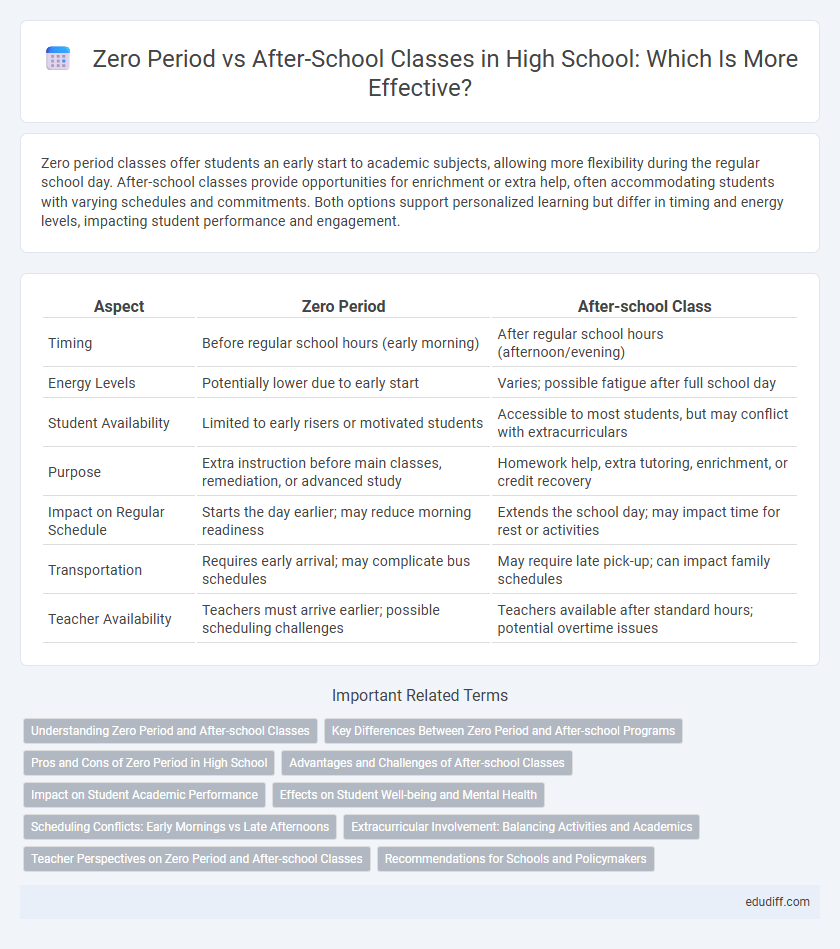Zero period classes offer students an early start to academic subjects, allowing more flexibility during the regular school day. After-school classes provide opportunities for enrichment or extra help, often accommodating students with varying schedules and commitments. Both options support personalized learning but differ in timing and energy levels, impacting student performance and engagement.
Table of Comparison
| Aspect | Zero Period | After-school Class |
|---|---|---|
| Timing | Before regular school hours (early morning) | After regular school hours (afternoon/evening) |
| Energy Levels | Potentially lower due to early start | Varies; possible fatigue after full school day |
| Student Availability | Limited to early risers or motivated students | Accessible to most students, but may conflict with extracurriculars |
| Purpose | Extra instruction before main classes, remediation, or advanced study | Homework help, extra tutoring, enrichment, or credit recovery |
| Impact on Regular Schedule | Starts the day earlier; may reduce morning readiness | Extends the school day; may impact time for rest or activities |
| Transportation | Requires early arrival; may complicate bus schedules | May require late pick-up; can impact family schedules |
| Teacher Availability | Teachers must arrive earlier; possible scheduling challenges | Teachers available after standard hours; potential overtime issues |
Understanding Zero Period and After-school Classes
Zero Period classes provide students with the opportunity to start their academic day early, enhancing time management and allowing for a more flexible schedule. After-school classes extend learning beyond regular hours, often supporting homework help, enrichment, or remedial instruction. Both options cater to different student needs, with Zero Period focusing on earlier engagement and After-school Classes emphasizing extended academic support.
Key Differences Between Zero Period and After-school Programs
Zero Period classes occur before the official school day begins, allowing students to earn credits earlier while maintaining their regular afternoon schedule. After-school programs take place once the traditional school day ends, providing extra instruction or enrichment but may interfere with extracurricular activities or family time. The primary distinctions lie in scheduling, with Zero Period offering an early start advantage and after-school programs emphasizing extended learning opportunities post-classes.
Pros and Cons of Zero Period in High School
Zero Period classes in high schools offer students the advantage of an earlier start, allowing for a more flexible schedule and the opportunity to take additional courses compared to traditional after-school classes. However, the early start time can impact students' sleep patterns and overall energy levels, potentially affecting academic performance and well-being. While Zero Period provides scheduling benefits, it requires careful consideration of students' health and extracurricular commitments to ensure a balanced routine.
Advantages and Challenges of After-school Classes
After-school classes offer extended learning opportunities beyond regular school hours, enabling students to deepen subject comprehension and improve academic performance. These sessions provide a more relaxed environment conducive to personalized instruction, but they can lead to student fatigue and reduced time for extracurricular activities. Managing transportation and scheduling conflicts poses additional challenges for both students and parents in maximizing after-school class participation.
Impact on Student Academic Performance
Zero period classes, scheduled before the official start of the school day, often enhance student academic performance by providing extra instructional time without interfering with after-school commitments. In contrast, after-school classes can lead to student fatigue and reduced focus due to extended school hours, negatively affecting learning outcomes. Research indicates that zero period participation correlates with higher grades and improved mastery of challenging subjects compared to after-school sessions.
Effects on Student Well-being and Mental Health
Zero Period classes, held early in the morning before the regular school day, can disrupt students' natural sleep cycles, potentially leading to increased fatigue and reduced mental health. After-school classes extend the school day and may contribute to heightened stress and less downtime for relaxation or extracurricular activities, negatively impacting students' overall well-being. Studies indicate that balanced scheduling with adequate rest supports better emotional regulation and academic performance among high school students.
Scheduling Conflicts: Early Mornings vs Late Afternoons
Zero Period classes starting before the regular school day can lead to early morning scheduling conflicts, impacting students' sleep and morning preparations. After-school classes held in late afternoons often clash with extracurricular activities, part-time jobs, and family responsibilities. Balancing these time slots requires careful consideration of students' overall commitments to maximize attendance and academic performance.
Extracurricular Involvement: Balancing Activities and Academics
Zero Period classes allow high school students to start coursework earlier, providing more flexibility for after-school extracurricular activities such as sports, clubs, and part-time jobs. After-school classes may enhance academic focus by dedicating time solely to studies, but they can limit participation in extracurricular involvement vital for social development and college applications. Balancing Zero Period with after-school activities demands effective time management skills to maintain strong academic performance while engaging in diverse interests.
Teacher Perspectives on Zero Period and After-school Classes
Teachers often view zero period classes as beneficial for students needing extra academic support while fitting into their regular schedules, offering a structured environment before the official school day. After-school classes, in contrast, provide opportunities for enrichment and remediation but can interfere with students' extracurricular activities and personal time. From a teacher's perspective, zero period sessions facilitate better attendance and engagement, whereas after-school programs may face challenges with consistent student participation.
Recommendations for Schools and Policymakers
Schools and policymakers should evaluate student performance data and well-being metrics to determine the optimal scheduling of zero period and after-school classes. Implementing evidence-based policies that consider students' circadian rhythms and extracurricular commitments can enhance academic outcomes and reduce burnout. Prioritizing flexible scheduling options and regular feedback from students ensures equitable access and supports holistic development.
Zero Period vs After-school Class Infographic

 edudiff.com
edudiff.com